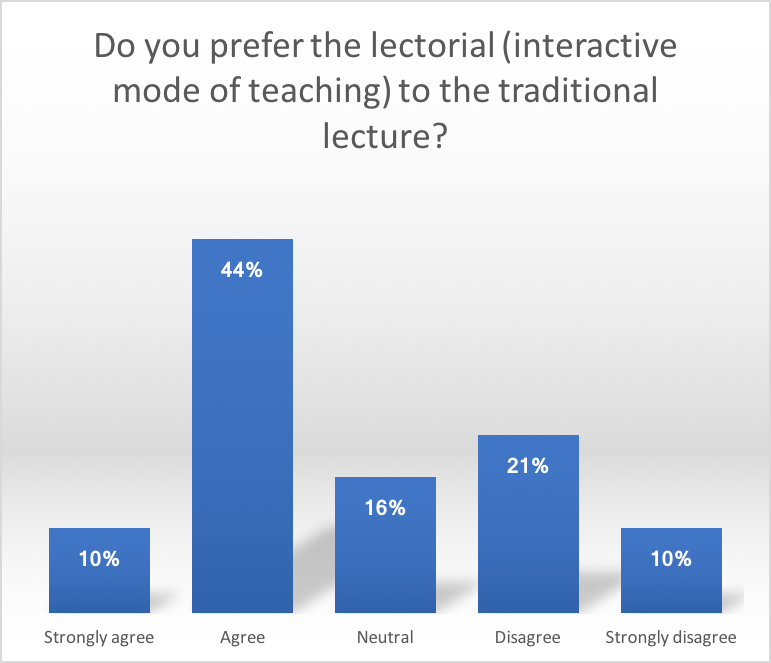
In this extended article for Teaching@Sydney, Dirk Moses, Professor of Modern History in the Faculty of Arts and Social Sciences, explores the hype, hopes and realities of flipped classrooms for teaching and learning in the humanities.
Interactive teaching is often presented as the holy grail of cutting-edge pedagogy. Replacing the traditional lecture with a “flipped classroom” would end the lecture blues and transform our relationship with our co-learners, the 18-year olds in our large first-year lectures. “Gone are the days of classrooms consisting simply of a lectern, a blackboard, and a passive sea of desks”, proclaims this university in its Unlearn marking campaign. “Our new undergraduate curriculum is no longer didactic – it fosters interaction, collaboration, dynamism and real-time problem solving”. Because students are partners in learning rather than passive recipients of knowledge, we were to be guides by the side, not sages on the stage.
I am unconvinced that this caricature accurately depicts what I’d experienced in good undergraduate lectures in this and other universities. Rarely did those lectures consist simply of a lectern and a blackboard before a sea of passive onlookers. On the contrary, they were responsive learning environments as we interspersed lecturing with discussion, information transmission with interaction and, dare I say, metacognitive moments. Lectures were, and are, never solely exercises in content delivery, but interpretive performances, less sage on the stage than guide on the stage.
Still, by 2016, I had become perplexed by the dramatic decline in lecture attendance in my first-year history unit on twentieth century Europe (hardly a boring topic); indeed, by the fact that half the class did not even attend the first and subsequent lectures. I decided to fully flip the classroom to see how lecture attendance, engagement, and overall satisfaction would be affected. The guinea pig would be the first-year students in INGS1002 Global Culture and Society, a core unit in the Bachelor of Global and International Studies, a degree that enrols highly qualified students with an ATAR of over 92.
Challenges of unit design
The challenge is to fill a two-hour lecture with interactional activities now that I would not be delivering a lecture: a dialogue instead of a monologue, an extended conversation, small group work and open discussion, letting a hundred flowers blossom and a hundred schools of thought contend. Alas, precious little information about how to flip classrooms was then available on the university website. One page – since disappeared — directed me to the University of Queensland for information but it too provided slim pickings. Late last year, two staff members in the Faculty of Arts and Social Sciences’ Teaching and Technology Innovation team answered my SOS emails and advised about the practicalities of interactional teaching. One recommended pedagogical technique was to conduct quizzes via the www.2s.lide or Socrative platforms. I declined to follow the other suggestion of historical role play.
The limitations of the available advice for humanities subjects soon became apparent. The unacknowledged fact is that the flipped classroom literature is directed to STEM (science, technology, engineering, and mathematics) subjects, in which lecturers impart first principles that students use to solve problems in small groups. They then report back to the class on the lecture screen via various technologies. Quizzes are a staple of this approach.
It is less useful with History, which is not a problem-solving discipline. Like others in the humanities and social sciences, History seeks understanding and explanation. Students need to know something about a historical episode or problem if they are to better comprehend and account for it. In INGS1002, we are interested less in testing factual knowledge than seeing whether students can understand new concepts (e.g., historical accident, contingency, conjuncture) and follow the complex global processes, connections, and relationships set out in the reading. Pop quizzes are ill-suited for this purpose. Writing and discussion – labour-intensive modalities of teaching – are the best vehicle.
The precondition of the flipped classroom is that the information transmission (content delivery) takes place before the lecture (hence flipped), whether by reading a text and/or viewing pre-recorded lectures. Lecture time can then be devoted to deepening understanding of the issues via group work and general discussion: “interaction, collaboration, dynamism and real-time problem solving”. The wager is that students prepare for the lecture.
The literature recognizes that students won’t do so, still less attend lectures, unless assessment tasks are embedded in them. That is another attraction of quizzes for the proponents of the flipped classroom. But it is also an unsolvable problem if you can’t set in-class assessments because many student have timetable clashes and/or work outside the university. It’s not as if this problem has been ignored here, but proffered solutions, like having students make videos, are untenable with first-year students in large lecture classes.
Flipping in practice
Thus armed, I designed the unit as follows:
- I ruptured the usual short essay + long essay + exam pattern of assessment. The short essay was replaced by weekly 8 x 200-word analyses of the readings (“lecture posts”), due the day after the lecture. The incentive to read the text and attend the lecture was the lecture’s focus on the questions that the students had to answer in the lecture post. In other units, such tasks are posted before the lecture (sometimes called “reflections”), but I reckoned that students would not attend the lecture if the assessment task had been completed already.
- The long research essay was to be submitted as a take-home exam at the end of the exam period (30 June) instead of late in the teacher semester, because we know that most students cannot devote the necessary time to the task when other large assessments are also due.
- To prepare students for the long essay, a draft introduction and annotated bibliography (1,000 words) was set for Week 9. Feedback on this task was designed to improve the long essay. In this way, the tutorials and long essay task were integrated and aligned.
- Tutorials were devoted solely to academic skills, in particular preparation for writing the long research essay. These were first year students, after all, many of whom struggle with university level essay writing: academic research, how to write an introduction, structure an essay, reference properly, and so forth. With Dr Bronwyn James, Director of Academic Enrichment, we designed an exercise for writing annotations, while Rena McGrogan and her crack team from the Library hosted two tutorials on database usage in Fisher Library.
I explained the unit’s philosophy in the first lecture. Teaching was to be interactive and dynamic; students were not to be passive recipients of knowledge: we would generate it together in a thrilling voyage of discovery. The lecture was to deepen knowledge/insights gained before the lecture in students’ reading. We watched a short video on the approach. Accordingly, I ran the two-hour lecture of 284 students as a giant tutorial, a “lectorial”. We workshopped the reading, trying to answer questions about the reading set out in the Unit Outline. Students broke into small groups for about 10 minutes of deliberation before we reconvened and fielded answers to the questions (show of hands). It was live theatre. We also watched short YouTube clips for discussion purposes. Metacognition was encouraged at each stage.
Did it work? It soon became clear that many students were not doing the preparatory reading. In response, I devoted time in each lecture for everyone to read key passages of the text that we would then discuss. Small group work was supplemented by class-wide discussion in later weeks as numbers dwindled.
Indeed, sure enough, as with traditional lectures, attendance fell in the second half of the semester. By Week 11, we had about 50, and only 30 or so in the last two weeks. Those lectorials were raging successes, incidentally: lively and engaged discussions. The interactive model of teaching works very well with small groups of motivated students. By then, the committed few had two months of reading under their belts, and the various strands of the unit were coming together.
What students thought: the good, the bad, the ugly… and the ambivalent
To gauge student response, I designed my own survey using a range of Likert scales and open-response questions. Of 284 students, 114 completed the survey. In response to the first question, Do you prefer the lectorial (interactive mode of teaching) to the traditional lecture? (Figure 1) 55% of students answered strongly agree to agree, 16% were neutral and 31% answered disagree to strongly disagree. 56% of students found the academic skills program in tutorials to be useful and 90% strongly agreed or agreed that the core text The Origins of the Modern World (Marks, 2002) was useful. What was especially successful was the lecture post assessment task, with 92% of students registering strongly agree to agree on the question Did you find the Lecture Post assessment task useful?: this survey feedback was further supported by student comments that the shortly, weekly task “forced” (their term) to do the reading; and they welcomed the regular feedback on their writing, despite this being a labour-intensive undertaking for the teaching team. Students also found the draft introduction and annotated bibliography assessment (80% strongly agree to agree) and long essay (take-home exam) assessment tasks (78% strongly agree to agree) useful. When combined with the USS results and student comments, these findings suggest the dilemmas posed in using flipped classroom.

Positive comments
- This subject was just amazing. The lecture (or ‘lectorials’ as Dirk calls them) have been incredibly engaging and enjoyable. The content was very interesting, and the format of having weekly lecture posts makes sure we understand the readings.
- I really enjoyed this unit. It was a great way to look at the world in a way that I may have not necessarily ever thought. I very much enjoyed the lectorial style as it opened up the floor to more debate and free flowing ideas, which encapsulates the essence of this topic and the degree. Thank you very much for the amazing learning opportunity and the varied perspectives you have brought to my learning.
- The interactive style forced me to do (or, at least, incentivised doing) the readings beforehand, which was good.
- The lectorial style was good – all subjects should do it. This was the only subject with a 2 hour lecture that didn’t get really boring in the second hour.
- In general I preferred the lectorial format. I think it’s a lot easier to learn when I’m engaged with the content, and have the opportunity to participate in discussions about it. I think it helped me think critically about it, rather than just passively listen to it.
Generally positive but with some ambivalence and good advice
- Less boring than a lecture which ensures focus. I think that you learn better from it which outweighs any cons which was that sometimes people just repeated the same thing, and i would’ve preferred to hear the lecturers (more credible perhaps) opinion on the question AS WELL as the students.
- the first lectorial we had where we were in distinct and defined groups with a set of questions to discuss was the best. All other lectorials which did not follow this pattern, i felt were not as beneficial.
- Yes, but not every single week. I think the learning framework could be more successful if there was a little more variety. Eg weeks 1-8 lectorials. 9-10 lectures and 11-13 lectorials.
- There is little incentive to come to lectures & do the readings in the last few weeks where the content is not assessable (as opposed to the other weeks where there were lecture posts to be completed)
Some students pointed out that lectorials favour certain personality types
- I found that this mode of teaching encourages outspoken students to consistently speak out, whilst students with anxiety or are less outspoken would remain silent.
- It works for those with strong opinions and the confidence to speak out, however, this doesn’t typify the majority of the cohort unfortunately.
- It was a little bit daunting having to speak in front of such a large crowd of people, which deterred me from attending.
Some students disliked small group work, preferring lecture-wide discussion
- I liked the idea of the lectorials and allowing for greater debate and influence from a wide range of perspectives, being my class mates. I liked the discussions as a whole, rather than breaking off into small groups, I feel as though it may have wasted some time, as sometime it was merely a discussion of what had happened or catching others up, instead of a deeper analysis. By having the whole class discussion it allowed for Dirk then to interject and force us to think even deeper.
- That being said, I think some models of the lectorial style worked better than others. I personally didn’t love the ‘pod’ system we used in the first few weeks, as I often found most people weren’t interested in contributing, and we didn’t get very far. I particularly liked the more general lecture-wide discussions towards the end of the semester, although obviously that was aided by the greatly reduced numbers.
There was plenty of criticism
- Difficult for people who work to be involved as they catch up on lectures online. [i.e., interaction in lecture is not picked up by the microphones]
- Did not attend enough of them as I had a clash with another subject.
- Useful for understanding concepts or historical events in a broader context – When it comes to details, defining terms etc. I personally would prefer a traditional lecture format.
- Having such a huge cohort allowed access to a diverse range of ideas/perspectives on the topics we were learning. However as uni students we can be very unreliable and not do the pre-readings. This meant some groups sat in silence for the times where we were asked to collaborate.
- While I did sometimes enjoy lectorials and feel as though they required me to engage with the content on a deeper level, I feel as though we never got through much content and I actually had to teach myself the majority of the content. Also, it was extremely frustrating repeatedly listening to students repeat what the previous student had said just in different terms. I feel as though in a traditional lecture a lot more content would have been covered, and it would have actually been coming from someone who knew what they were talking about, not just other students who had a similar knowledge base to myself and needed to be educated
- The ‘lectorial’ method of teaching is well intended but really not that useful. It’s difficult to engage in group work in a large lecture theatre and to get everyone to participate. I also think that it takes time away from the hearing the professor’s ideas and explanations
Some criticism was biting. These seem like very smart students to me.
- Relies too much on students doing the readings (which is ideal but not what tends to happen after week 2). I think most students learn better and prefer a more traditional lecture style. The ever evolving format of the lectures and tutorials [is a problem]. In the 13 weeks I’ve attended these lecture they have moved from a ‘Lectoral’ to a ‘Quecture’ and back again and it’s exhausting having to marvel at a new ‘ground breaking’ format every time someone decides to slightly change the lecture structure. It’s still just a lecture with a fancy name.
- Realistically collaborative learning en masse can quickly turn into a muddle of mixed opinions; “interactive learning” is a colourful concept, and can be a useful tool for particular subjects. … [but] … my experience in INGS1002 has taught me that the study of world history and the grand narrative within this structure if anything is overcomplicated, drawn out and a reflection of what might happen when a unit coordinator gets side tracked with ‘modern learning techniques’ and as a result sacrifices students learning potential on a whim …. perhaps next semester the learning format might be similar to a Montisori or Steiner version of learning
Lessons to take away…
The survey evidence suggests that the unit was a curate’s egg. Overall, I over-egged the omelette, flipping the class entirely instead of partially. Many students want the lectures sunny side up, which is to say, a yolky tutorial core supported by the white of lecturing. Here are my takeaways:
- Some of the most able students preferred the traditional lecture over the flipped alternative. About a third of students indicated that they prefer the traditional lecture. Judging by their articulate vehemence, there are good reasons for thinking that they are the most able students. One made a plea for tradition by appealing to student autonomy and maturity – the very attributes supposedly fostered by interactive teaching: “I would argue that the traditional format – without university skills tutorials – requires students to be self sufficient and learn from mistakes, do the work or fail.” This student, at least, would likely resist the, frankly, questionable assertion in one academic paper on flipped classrooms that “Learning has ceased to be an internal and individual activity, and has become an activity performed collectively, online.”
- Flipping the classroom did not improve lecture attendance. Lecture attendance patterns were no different than for a traditional lecture. What is more, some students avoided the lecture because of the interaction. Many students are yearning for more than just peer learning. Many don’t necessarily want an interactive experience with their unprepared peers. They want to learn from lecturers as models of comportment and thinking in their discipline. Restrict the interaction to the tutorials, they are saying. Content delivery matters.
- While response was mixed, 54% of students preferred the lectorial. And yet, 54% preferred the lectorial. The class is polarised. I suspect students who did not prepare for class enjoyed it more because they could “catch up” on the material. Is that what we intend with the flipped classroom? If flipping is a wager based on student preparation, what if most don’t accept the wager? As noted above, a possible answer is to make lectures compulsory and/or embed in-lecture assessment. But we can’t do that when the university allows timetabling clashes. Student work commitments off-campus also preclude such innovations.
- Finding lecture activities that appeal to all students in a varied cohort is difficult. Some students liked small group work (pods), others disliked it. Some preferred lecture-wide discussion, others were intimidated by it. Clearly, students vary in preparation, confidence, and ability. With this heterogeneous student body – including many international students – there is no one-size-fits-all answer to the teaching modality question.
- Replicating content in tutorials can make the lectorials seem redundant. Many students regarded a full semester of tutorials on academic skills as excessive. They urged content-rich tutorials. So the lectorial approach places teachers in a bind: why should students come to interactive lectures if they’ll cover the content in tutorials? Even so, despite the many negative comments, 56% agreed that the skills program was useful, while 25% disagreed. Certainly, the quality of the long essay was better than equivalent first-year work I’ve marked. There is no easy answer here. It’s unfair to make students prepare for lecture and tutorials. If you flip the lecture, the tutorials can’t replicate them. Academic skills need to be embedded in content-rich material that can be worked through without preparation. Devising such tasks is the challenge.
- The learning space shapes what you can and cannot do. A large class in an inappropriate teaching space is inimical to general discussion and to the formation of small groups. The university talks a big game about interactive teaching infrastructure but in fact does not provide the necessary learning spaces for units above 120 students. At any rate, it is questionable whether flipping the classroom in the humanities can work with units of that size.
- While student satisfaction did not improve uniformly, students appreciated some of the subject redesign. The satisfaction rate for INGS1002 was about the same as for my traditionally taught first- year units. Lecture attendance declined in the usual way because student assessments are bunched at the end of the semester. Students are rational actors. They calculate that their time is better spent meeting their many deadlines than attending non-compulsory lectures with no directly assessable tasks. If we want to address lecture attendance, we should organise our assessment tasks in different ways. I addressed this issue by placing the long-essay at the end of the exam period, and students appreciated it.
- Flipping the lecture does not translate to lecture recordings. Students who were unable to attend the lecture (due to timetable clashes or work commitments) found the recordings unsatisfactory because the discussion takes place in the lecture theatre away from the lectern microphone. The university has not addressed its competing imperatives: allowing students to enrol in up to three clashing units (!), thereby consenting to lecture absence, while assuring them they can manage by listening to them online. It doesn’t work.
- How much do we adjust to suit students immediate needs , as opposed to their future ones? Do we capitulate to 18 year-old attention spans (change gears every 15 minutes I was advised by the Educational Innovation staff, because students cannot concentrate for longer periods) or do we train students in the vanishing art of active listening and note-taking?
- Partial flipping may be more suitable than the fully flipped model. When I next offer the unit, I’ll keep the assessment architecture, which worked well, but amend the lectorial. There will be more lecturing and less group work. That is, I’ll only partially flip the classroom.
Conclusions and final thoughts
I have often observed that the traditional lecture can capture student attention when done well. One guest lecturer in my current unit – a distinguished senior scholar – spoke for 50 minutes without notes or powerpoint slides, and the students were transfixed. They could see that there was something to be learned here. Contrary to the polemics against the traditional lecture, their listening is far from passive: the students had covered a book chapter and document on the subject for that week’s tutorial, and could thus correlate and/or integrate the lecture with their own reading. Listening and note-taking can be creative acts of judgment and synthesis. I naturally agree that we should all “be brave enough to question the world, challenge the established, demolish social norms and build new ones in their place”, as the Unlearn campaign tells us. This is old news. In FASS, we’ve always called these aspirations “critical thinking”. Gayatri Spivak puts it thus: “I believe responsible humanities teaching strives at uncoercive rearrangement of desires in the student”. This is not really unlearning; it’s learning how to think for yourself – a positive rather than a negative attribute. Next year, I’m experimenting again: folding the tutorial into a three-hour lecture (with breaks of course). I’ll survey the those students, too. Watch this space.





